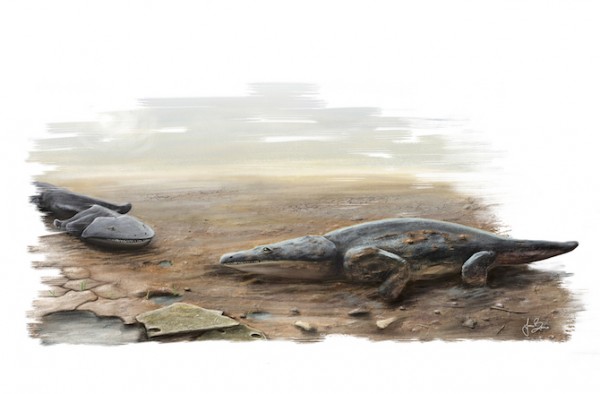Scientists Discover Remains of Giant Prehistoric Salamander
| Marco Foronda | | Mar 24, 2015 09:38 AM EDT |
(Photo : Joana Bruno) The animals had very flattened heads and lots of sharp teeth
Fossils of a new species of a giant salamander-like predator date from a time when amphibians were big and scary.
The predator called Metoposaurus algarvensis lived around 220 million years ago and likely consumed mostly fish. They came from an ancient lake bed in Portugal.
Like Us on Facebook
Steve Brusatte of the University of Edinburgh and his colleagues suggest that it's a distant relative of today's mostly small salamanders, frogs and newts. The Triassic beasts, however, lived much like modern fish-eating crocodiles and included species up to nine meters long.
M. algarvensis, which could grow two meters long, had a flattened skull with abundant little teeth. The head must have looked a bit like a toilet seat with the lid down when the jaws closed.
Brusatte believes the super salamander is a type of totally bizarre, otherworldly extinct animal.
"This new amphibian looks like something out of a bad monster movie. It was as long as a small car and had hundreds of sharp teeth in its big flat head, which kind of looks like a toilet seat when the jaws snap shut. It was the type of fierce predator that the very first dinosaurs had to put up with if they strayed too close to the water, long before the glory days of T. rex and Brachiosaurus," Brusatte said.
M. algarvensis seems to have been sensitive to changes in climate. Researchers suggest that many died at the Portuguese site when the lake they inhabited dried up. This perhaps foreshadowed what was to come some 20 million years later.
There was a mass extinction event 201 million years ago that wiped out most big amphibians like this. At this time, the supercontinent Pangea, which included all of the world's present day continents, began to break apart.
The changes are significant for dinosaur fans as the extinctions paved the way for dinosaurs to become the number one terrestrial predators.
Details of the new discovery were published in the Journal of Vertebrate Paleontology.
TagsScientists Discover Remains of Giant Prehistoric Salamander, Super Salamander, salamander, Fossils, predator, amphibian, Metoposaurus algarvensis, Dinosaur era, T-Rex, supercontinent Pangea
©2015 Chinatopix All rights reserved. Do not reproduce without permission
EDITOR'S PICKS
-

Did the Trump administration just announce plans for a trade war with ‘hostile’ China and Russia?
-

US Senate passes Taiwan travel bill slammed by China
-

As Yan Sihong’s family grieves, here are other Chinese students who went missing abroad. Some have never been found
-

Beijing blasts Western critics who ‘smear China’ with the term sharp power
-

China Envoy Seeks to Defuse Tensions With U.S. as a Trade War Brews
-

Singapore's Deputy PM Provides Bitcoin Vote of Confidence Amid China's Blanket Bans
-

China warns investors over risks in overseas virtual currency trading
-

Chinese government most trustworthy: survey
-

Kashima Antlers On Course For Back-To-Back Titles
MOST POPULAR
LATEST NEWS
Zhou Yongkang: China's Former Security Chief Sentenced to Life in Prison

China's former Chief of the Ministry of Public Security, Zhou Yongkang, has been given a life sentence after he was found guilty of abusing his office, bribery and deliberately ... Full Article
TRENDING STORY

China Pork Prices Expected to Stabilize As The Supplies Recover

Elephone P9000 Smartphone is now on Sale on Amazon India

There's a Big Chance Cliffhangers Won't Still Be Resolved When Grey's Anatomy Season 13 Returns

Supreme Court Ruled on Samsung vs Apple Dispute for Patent Infringement

Microsoft Surface Pro 5 Rumors and Release Date: What is the Latest?










